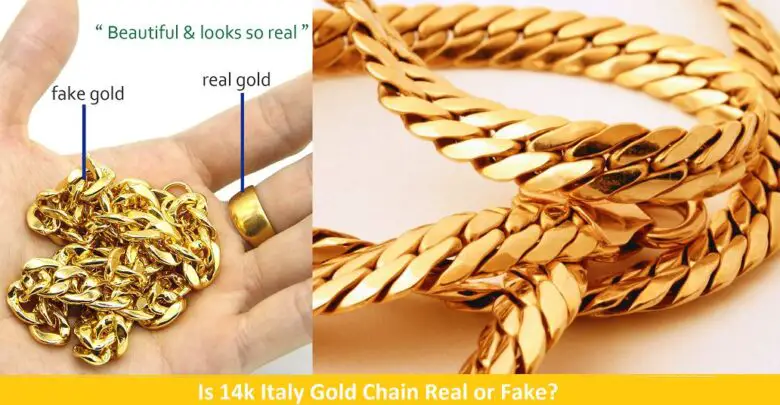When it comes to gold jewelry, determining its authenticity can feel like deciphering a riddle wrapped in an enigma. Have you ever glanced at an 18k gold chain and wondered: “Is this magnificent piece of jewelry the real deal, or just a clever imitation?” The allure of gold has captivated humans for millennia, but so too has the propensity for counterfeit versions. Navigating the landscape of gold authenticity might seem daunting, but armed with the right knowledge, you can confidently distinguish the genuine from the fake.
First and foremost, understanding what “18k gold” signifies is essential. The term “18k” indicates that 18 out of 24 parts of the alloy are pure gold. This means that it is 75% gold content, with the remaining 25% composed of other metals such as copper, silver, or palladium, enhancing its durability and color. Thus, the challenge lies in determining whether the chain you possess or are considering purchasing is indeed composed of this noble alloy.
Let’s embark on a journey of exploration, exploring several methods to assess the authenticity of an 18k gold chain.
1. The Hallmark Hunt
Your first port of call should be the hallmark or stamp usually found on gold jewelry. Authentic 18k gold is often imprinted with a hallmark indicating its purity. Look for markings such as “18k,” “750,” or even the manufacturer’s logo. Familiarize yourself with the standard stamps that correspond to gold purity. However, be warned: counterfeiters can replicate these stamps, so it may not be foolproof. It’s an intriguing puzzle, isn’t it?
2. The Magnet Test
Gold is not magnetic. A simple magnet can be your trusty companion in your quest for authenticity. Hold a magnet close to your necklace; if it clings to the metal, you likely have a fake on your hands. It’s almost like a game of hide and seek, where the genuine article playfully evades the magnetic pull. However, this test should be considered a preliminary step, as some gold-plated pieces may pass this test. Therefore, consider this method as part of a larger investigative toolkit.
3. The Acid Test
For a more definitive confirmation, the acid test presents an option—albeit a bit more intense. It involves applying a small drop of nitric acid on the piece. Pure 18k gold will not react to the acid, whereas lower-karat gold or fake gold will. The test, while startling, can be incredibly informative. Just be cautious; this method requires precision and expertise to avoid damaging the piece. Do you dare to try it, or does the thought leave you feeling a tad squeamish?
4. The Weight Factor
The weight of your gold chain can also be a suggestive indicator of authenticity. Gold is denser than many other metals used in jewelry. If you have access to a reliable scale, weigh the chain. Compare the weight to the expected weight of similar chains based on their size and design. An unusually light chain could raise a flag, signaling that something may be amiss. This approach adds a tactile dimension to your investigation.
5. The Color Clue
The color of the gold can provide vital hints about its authenticity. Genuine 18k gold has a warm, rich hue that often distinguishes it from lower-karat gold or gold-plated items, which tend to have a more yellow sheen. Take a close look at the chain; does it radiate a soft glow, or is the color too bright and flashy? That subtle difference in tone can lead you closer to an answer.
6. Consult a Professional
When in doubt, seek the guidance of a qualified jeweler. Many jewelers offer appraisal services and can accurately determine the gold’s authenticity using advanced testing methods. This avenue is often the most reliable when you’re uncertain, transforming your challenge into a simple consultative session—no wild guesses involved here.
7. Buyer Beware: Purchase from Reputable Sources
In your quest for authenticity, the vendor plays a crucial role in the narrative. Acquiring gold jewelry from reputable jewelers or trusted retailers significantly minimizes the risk of ending up with counterfeit items. Always do your due diligence; read reviews and seek recommendations. Visiting a favored local jeweler or an established online retailer can ensure a smoother sailing experience through the tumultuous waters of jewelry shopping. How many seekers have been misled by an alluring price tag, only to discover their treasure was nothing but fool’s gold?
8. Embracing Alternatives
Should the idea of continuously verifying the authenticity of gold chain jewelry feel burdensome, consider exploring alternative materials that might offer a compelling aesthetic without the pitfalls of authenticity worries. Options like sterling silver or more affordable gold-plated pieces can provide elegance and charm without the intricate assessment processes. After all, the essence of jewelry lies in how it makes you feel, transcending mere material characteristics.
As you embark on this thrilling venture of identifying the authenticity of an 18k gold chain, remember that knowledge is your greatest asset. Regardless of whether you’ve landed a stunning genuine piece or an unfortunate counterfeit, being informed empowers your shopping experience and fortifies your appreciation for this timeless medium of self-expression. So, the next time you catch yourself pondering the golden query—“Is this chain real or fake?”—you’ll be equipped with tools, insights, and the joy of discovery, turning a mere inquiry into an engaging adventure.
